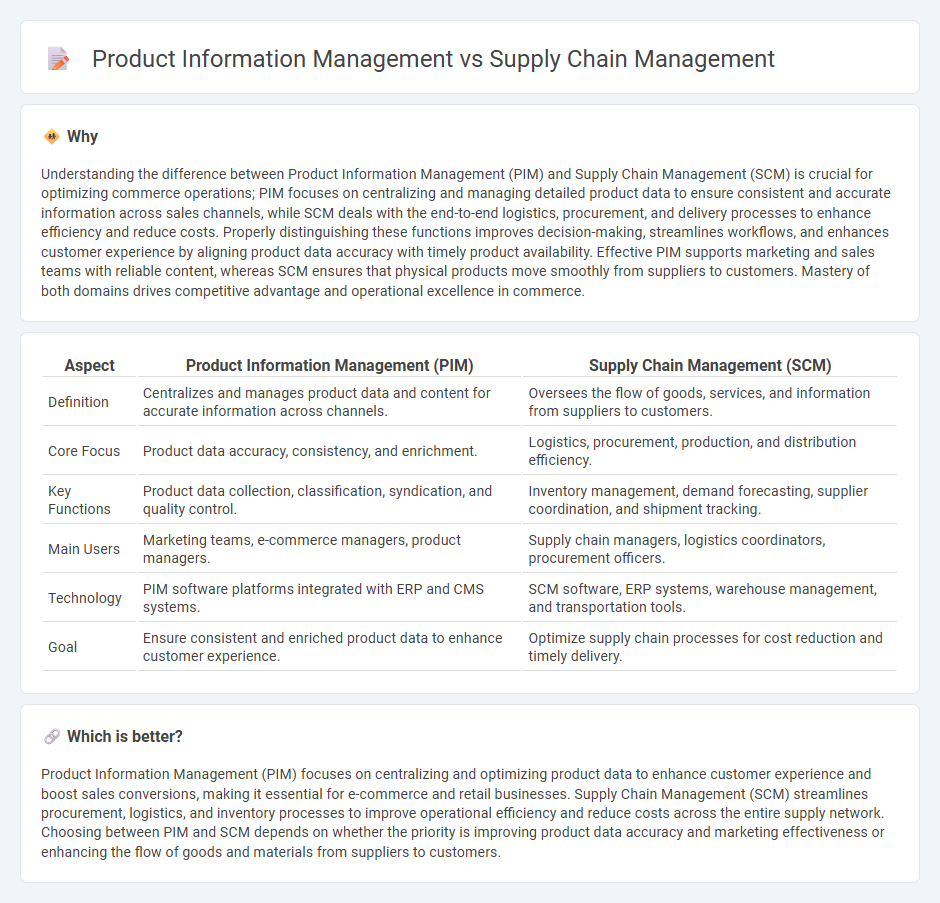
Product information management (PIM) centralizes and streamlines product data across sales channels to ensure accuracy and consistency, enhancing customer experience and reducing errors. Supply chain management (SCM) focuses on overseeing the flow of goods, information, and finances from suppliers to end consumers, optimizing efficiency and minimizing costs. Explore the differences and benefits of PIM and SCM to improve your commerce strategy.
Why it is important
Understanding the difference between Product Information Management (PIM) and Supply Chain Management (SCM) is crucial for optimizing commerce operations; PIM focuses on centralizing and managing detailed product data to ensure consistent and accurate information across sales channels, while SCM deals with the end-to-end logistics, procurement, and delivery processes to enhance efficiency and reduce costs. Properly distinguishing these functions improves decision-making, streamlines workflows, and enhances customer experience by aligning product data accuracy with timely product availability. Effective PIM supports marketing and sales teams with reliable content, whereas SCM ensures that physical products move smoothly from suppliers to customers. Mastery of both domains drives competitive advantage and operational excellence in commerce.
Comparison Table
| Aspect | Product Information Management (PIM) | Supply Chain Management (SCM) |
|---|---|---|
| Definition | Centralizes and manages product data and content for accurate information across channels. | Oversees the flow of goods, services, and information from suppliers to customers. |
| Core Focus | Product data accuracy, consistency, and enrichment. | Logistics, procurement, production, and distribution efficiency. |
| Key Functions | Product data collection, classification, syndication, and quality control. | Inventory management, demand forecasting, supplier coordination, and shipment tracking. |
| Main Users | Marketing teams, e-commerce managers, product managers. | Supply chain managers, logistics coordinators, procurement officers. |
| Technology | PIM software platforms integrated with ERP and CMS systems. | SCM software, ERP systems, warehouse management, and transportation tools. |
| Goal | Ensure consistent and enriched product data to enhance customer experience. | Optimize supply chain processes for cost reduction and timely delivery. |
Which is better?
Product Information Management (PIM) focuses on centralizing and optimizing product data to enhance customer experience and boost sales conversions, making it essential for e-commerce and retail businesses. Supply Chain Management (SCM) streamlines procurement, logistics, and inventory processes to improve operational efficiency and reduce costs across the entire supply network. Choosing between PIM and SCM depends on whether the priority is improving product data accuracy and marketing effectiveness or enhancing the flow of goods and materials from suppliers to customers.
Connection
Product Information Management (PIM) enhances Supply Chain Management (SCM) by centralizing and standardizing product data, ensuring accuracy and consistency across all supply chain stages. Efficient PIM enables better demand forecasting, inventory management, and supplier collaboration by providing comprehensive product details in real-time. This integration reduces errors, accelerates product launches, and drives operational efficiency throughout global commerce networks.
Key Terms
Logistics (Supply chain management)
Supply chain management (SCM) optimizes logistics by streamlining the flow of goods, managing inventory levels, and coordinating transportation to ensure timely delivery and cost efficiency. Product information management (PIM) supports logistics by maintaining accurate, centralized product data that enhances order accuracy and reduces fulfillment errors. Discover how integrating SCM and PIM can transform logistics operations for maximum efficiency and customer satisfaction.
Data Centralization (Product information management)
Product information management (PIM) centralizes product data across multiple platforms, ensuring consistency, accuracy, and up-to-date details for seamless product lifecycle management. In contrast, supply chain management (SCM) focuses on optimizing logistics, procurement, and inventory flow without the deep integration of product content centralization. Explore how PIM's data centralization enhances merchandising and omnichannel strategies by streamlining product information across systems.
Inventory Optimization (Supply chain management)
Supply chain management (SCM) focuses on inventory optimization by streamlining procurement, demand forecasting, and distribution processes to minimize stockouts and excess inventory, thereby reducing costs and improving customer satisfaction. Product information management (PIM) enhances inventory accuracy by maintaining consistent and detailed product data, which supports better decision-making in supply chain operations. Explore the critical differences and integrations between SCM and PIM for advanced inventory optimization strategies.
Source and External Links
What is Supply Chain Management? Roles, Salaries, and Career - Supply chain management involves coordinating activities from planning and sourcing to delivering goods or services, focusing on efficiency to avoid delays and ensure smooth transitions between steps in the supply chain.
What Is Supply Chain Management? - IBM - SCM is the coordination of the entire production flow--from sourcing raw materials to delivering finished products--aimed at optimizing the network of suppliers, manufacturers, distributors, and customers to minimize costs, waste, and time while improving profitability and competitiveness.
Supply chain management - Wikipedia - SCM is a cross-functional system managing procurement, operations, logistics, and marketing to minimize costs and improve collaboration, inventory visibility, and the velocity of inventory movement, including emerging concepts like Circular Supply Chain Management for sustainability.
 dowidth.com
dowidth.com